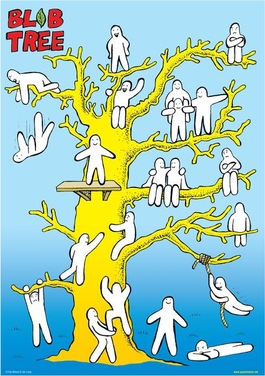Blob Tree
Blob Tree is a psychological tool developed to help individuals, particularly children, express their feelings and emotions in a non-verbal manner. It was created by British therapist Pip Wilson, who designed the Blob Tree as a way to facilitate communication about emotions and personal experiences, especially in settings where verbal articulation might be challenging or limited.
Overview[edit | edit source]
The Blob Tree consists of a series of drawings depicting various blob-like figures situated on a tree. Each blob character is engaged in different activities or exhibiting distinct postures and expressions. These blobs are intentionally designed without specific gender, age, or cultural characteristics to allow broad identification from individuals. Participants are asked to identify with one or more blobs that they feel represent their current emotional state or situation.
Usage[edit | edit source]
The Blob Tree is utilized in a variety of settings, including counseling, education, and corporate environments. In therapy sessions, it serves as a projective technique, encouraging individuals to project their feelings onto the blob characters. This can help therapists to initiate discussions about difficult topics in a less confrontational way. In educational settings, teachers use the Blob Tree to understand students' feelings and to foster emotional intelligence. In the corporate world, it can be a tool for team building, helping to identify how team members feel about their work, their place within the team, and their interactions with each other.
Interpretation[edit | edit source]
Interpreting the Blob Tree involves discussing why an individual identifies with a particular blob or blobs. The position of the blob on the tree, its activities, and its interactions with other blobs can all provide insights into the person's emotions, self-perception, and social relationships. For example, a blob at the top of the tree might represent feeling happy or in control, while a blob at the bottom might indicate feelings of being overwhelmed or unsupported.
Benefits[edit | edit source]
The Blob Tree offers several benefits as a psychological tool. It provides a visual and tangible way for people to express complex emotions, which can be particularly useful for those who find verbal expression difficult. It also promotes empathy and understanding within groups by helping members see and discuss the range of feelings present. Furthermore, it can be a non-threatening way to start conversations about personal development and emotional well-being.
Criticism[edit | edit source]
While the Blob Tree is widely used and appreciated for its simplicity and effectiveness, some critics argue that its interpretative aspect can be too subjective. The risk of projecting one's own interpretations onto another's choice of blob can lead to misunderstandings. Therefore, it is crucial for facilitators to approach discussions with openness and without presumption, allowing individuals to fully explain their choices.
Conclusion[edit | edit source]
The Blob Tree is a valuable tool in the field of psychology, education, and beyond, offering a unique and accessible way for individuals to explore and communicate their emotions. Its simplicity and versatility make it a popular choice among professionals looking to foster emotional awareness and empathy in various settings.
Search WikiMD
Ad.Tired of being Overweight? Try W8MD's NYC physician weight loss.
Semaglutide (Ozempic / Wegovy and Tirzepatide (Mounjaro / Zepbound) available. Call 718 946 5500.
Advertise on WikiMD
|
WikiMD's Wellness Encyclopedia |
| Let Food Be Thy Medicine Medicine Thy Food - Hippocrates |
Translate this page: - East Asian
中文,
日本,
한국어,
South Asian
हिन्दी,
தமிழ்,
తెలుగు,
Urdu,
ಕನ್ನಡ,
Southeast Asian
Indonesian,
Vietnamese,
Thai,
မြန်မာဘာသာ,
বাংলা
European
español,
Deutsch,
français,
Greek,
português do Brasil,
polski,
română,
русский,
Nederlands,
norsk,
svenska,
suomi,
Italian
Middle Eastern & African
عربى,
Turkish,
Persian,
Hebrew,
Afrikaans,
isiZulu,
Kiswahili,
Other
Bulgarian,
Hungarian,
Czech,
Swedish,
മലയാളം,
मराठी,
ਪੰਜਾਬੀ,
ગુજરાતી,
Portuguese,
Ukrainian
Medical Disclaimer: WikiMD is not a substitute for professional medical advice. The information on WikiMD is provided as an information resource only, may be incorrect, outdated or misleading, and is not to be used or relied on for any diagnostic or treatment purposes. Please consult your health care provider before making any healthcare decisions or for guidance about a specific medical condition. WikiMD expressly disclaims responsibility, and shall have no liability, for any damages, loss, injury, or liability whatsoever suffered as a result of your reliance on the information contained in this site. By visiting this site you agree to the foregoing terms and conditions, which may from time to time be changed or supplemented by WikiMD. If you do not agree to the foregoing terms and conditions, you should not enter or use this site. See full disclaimer.
Credits:Most images are courtesy of Wikimedia commons, and templates, categories Wikipedia, licensed under CC BY SA or similar.
Contributors: Prab R. Tumpati, MD

